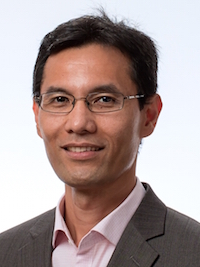 Rudy Purba
Rudy Purba
Director – Development Projects
ANUedge, The Australian National University, Canberra
Public Policy Program (’01)
Please tell us about your career path so far. What is your area of specialization and how did you come to work in this area?
After I finished my engineer’s degree (Ingenieur/Ing.), studying both at The Hague University and Delft University of Technology (TU Delft) in the Netherlands, I started my career as technology research planner and policy analyst in Indonesia with the Agency for the Assessment and Application of Technology (BPPT), Indonesian government research centre for engineering and technology, coordinated by the Ministry of Research and Technology (Ristek). I worked at BPPT as a planner with various roles including Program Manager of a 3-year World Bank-funded Science and Technology Indicators project to support technology policy making within Ristek and BPPT. In the same period until 1999 I also led some project teams in conducting analysis on research policy, technology and innovation policy, monitoring and evaluation of technology research projects, technology foresight, and public-private research partnerships.
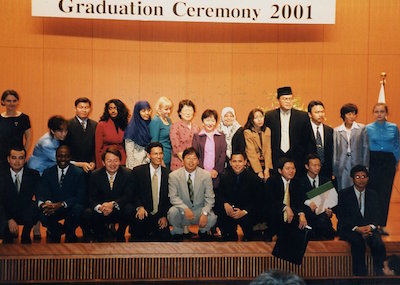
With fellow GSPS students of batch 1999-2001.
Driven by the lesson that innovation ideally should be driven from the business and industry sector and challenged to be standing on this side, combined with the facts that the Asian economic crisis in Indonesia on that time significantly reduced work activities, I decided to resign from BPPT and to work for an industrial technology think tank and consulting. Later I co-founded and developed my own businesses in Jakarta in the areas of supply chain and logistics, telecommunications and oil product manufacturing.
I moved to Canberra in 2007 with my Australian wife where I have built my career in international development with AMSAT International (linked to former Australian Marine Science And Technology). With AMSAT I was responsible for managing international development projects in marine and maritime areas, education and maritime infrastructures, which covered projects in Indonesia, other ASEAN countries, South Asia and Pacific countries. Since late 2013 I have taken up my current role as Director of Development Projects at the ANUedge.
You are currently working as Director Development Projects at ANUedge. Please tell us about ANUedge and your main responsibilities and duties?
ANUedge is the consulting part of ANU Enterprise Pty Limited (ANUE), a wholly-owned subsidiary of the Australian National University (ANU) in Canberra, the capital city of Australia. ANUedge conducts research- and academic-based consulting by applying research and expert knowledge from the ANU to real-world solutions. ANUedge’s consulting work is provided at all scales in sectors as diverse as gender, social impact assessment, governance, climate change, environmental management, business innovation, leadership and organisation capacity building, and industry strategy. Its clients include large multinationals, government agencies, industry bodies, and international development agencies.
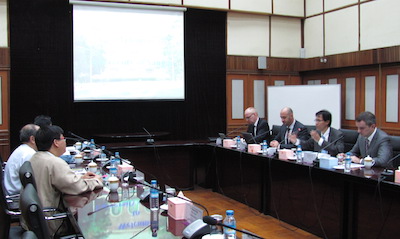
ANU team met with University of Yangon’s Rector and Department Heads to commence a university to university collaboration.
As Director of Development Projects I lead the activity of sourcing, pursuing and securing new businesses mainly in the area of international development projects through ANUedge’s clients and network of ANU academics and associates. My main clients are international development agencies such as AusAID (now Department of Foreign Affairs and Trade/DFAT), United Nations’ agencies and multilateral banks such as the World Bank and Asian Development Bank (ADB). My duties include project design and development, and establishing and strengthening international cooperation with project partners in the Asia-Pacific countries. In a nutshell my duty is to bridge the research and knowledge capacity of ANU’s academics and associates to commercial market of (international) development projects. The research capacity or the knowledge provided to projects are those not constrained by patent or Intellectual-Property (IP) rights. This capacity is also utilised in accord with specific ANU rules with regard to consulting engagement outside teaching and research work. With the aim to provide excellent and innovative solutions to clients and to expand and enhance our network in the global market I also connect our ANU academics/researchers with external consultants to work collaboratively through projects.
In your current capacity, what do you see as the main opportunities and challenges for ANU to commercialize its products.
This is a challenging question. This issue can also be discussed from various perspectives. ANUedge was designed to provide consulting services. The idea was for research capabilities to be commercialised utilising the ANU academics and researchers who have capacities to produce, or who own or integrate knowledge. Commercialisation of other ANU’s products resulting from research and academic activities, which are usually technology-based research products protected by IP rights or patents, is mainly managed by a different office within the ANU.
ANUedge’s long-established project management and knowledge integrating capacity combined with ANU’s strong research capacity can be utilised to respond to the increasing socioeconomic growth in Asia-Pacific countries. This growth creates a niche market with expanding demand both in consulting services and research-based technological products. At the same time, provision of innovation into our expert consulting solutions may trigger requirements for extra risk assessment. We are constantly challenged with finding the balance between our business propositions and clients’ requirements while achieving efficiency and effectiveness in our service. ANUedge look for opportunities generated by economic growth and innovation where research and knowledge transfer capacity of ANU is in demand. As ANUedge is bridging between university capacity provided by research-orientated academics and the commercial demands of the outside market, our main challenge lies in matching the requirements of the market and the research objectives of our academics. Therefore ANUedge plays a key role as to bridge, to enable and to strengthen academy-business/industry collaboration.
What are some of the biggest challenges you face in your work? And what have been the most interesting or rewarding aspects of your career thus far?
A large part of funding for international development projects is still sourced from Official Development Assistance (ODA). DFAT, an example of ODA source, is still one of the largest funders for our development projects. The landscape of ODA in the world is changing, with countries that once only received ODA now become donor countries, such as China and India. Consequently, long-established donors and their aid agencies such as DFAT had to adjust their budget priorities, reshape and reorganise their aid structures. Due to this the challenge is to find the balance between where our work can provide significant positive impact to the project stakeholders in recipient countries and how available aid funding is provided into particular fields or aid sectors. Another challenge is to reduce ANUedge’s dependency on only a few ODA sources. To achieve this I am working to increase our involvement in projects funded by other multilateral development banks such as the World Bank and ADB. Now as private sector engagement in development assistance work becomes more important, innovative thinking leading to innovative solutions through project implementation has become critical too. I like to combine my understanding of aid project activities with my innovation analysis experience to design innovative aid projects.
One most rewarding aspect in my career so far is being able to connect research with business. It generates revenue streams to support ANU research capacities. ANUedge is the right place to do that. It becomes a “bridge” that allows me to expand my network to the research and academic people or experts within the ANU and to link them to the network in the global market which consists of government stakeholders, multilateral agencies, businesses and communities; bringing values to the research and creating benefits to the communities.
What led you to GRIPS? What is the most important thing you got out of your studies here, and how has your experience at GRIPS prepared you for future endeavours?
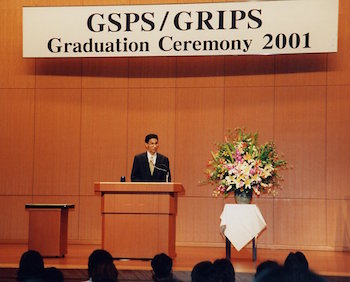
As President of the Student Committee delivering Graduation speech.
I heard the name of Graduate School of Policy Science (GSPS) of Saitama University, the predecessor of GRIPS, from my seniors at BPPT when I was working in the technology and innovation policy division dealing with policy design. In fact my former Director at BPPT, who became the Chairman of Indonesian Institute of Sciences (LIPI) until recently (2010 – 2014) and also an alumnus of GSPS/GRIPS, wrote the recommendation letter for me to support my application for the Monbukagakusho scholarship and to attend the selection test for this GSPS study. Prof. Lukman Hakim is also one of our GRIPS Alumni of the Month.
As probably the oldest and largest internationally-orientated policy science graduate school in Japan GRIPS, preceded by GSPS, has provided me with a strong multidisciplinary education taught by many professors graduated from the world’s prestigious universities. During my study I was taught not only by professors who graduated from Tokyo and Kyoto University, but also by those who received their graduate degrees and PhDs from Harvard, MIT, Stanford, Columbia, Cornell and Yale. I am grateful to have the opportunities to learn from such high calibre professors. Our classes were small so that interactive communication during lectures between these professors and students provided better insights and created strong motivation in mastering the subjects. During one year research and thesis writing, under Prof. Fujio Niwa’s supervision, I could learn about the strong Japanese discipline, systematic approach in tackling problems, good preparation before coming to productive thesis discussions, and an eye for details as I dealt with data and numbers in my factor analysis work.
The most important thing I got from my studies at GRIPS is the ability to analyse policies through research with multidisciplinary approach as taught by professors who were also experienced policy practitioners with the government. They could bring real policy cases based on their experience and provided lessons on problem solving and decision-making processes.
What is your fondest memory of your time spent at GRIPS? And what do you miss about Japan?
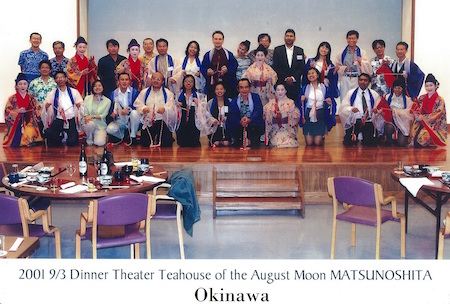
GSPS/GRIPS study trip to Okinawa. Dinner with Okinawan business federation.
As President of the Student Committee, I also led the preparation of students’ social activities including parties for the GSPS/GRIPS students. Bonenkai parties are always memorable to me. The fondest memory is certainly all the study trips that I joined; to see Japanese landscapes and culture outside the study element of the trips. Going to Hokkaido to see famous Sapporo beer industry and Sakhalin, part of Russian land across the sea, seen from the northern tip of Hokkaido island, enjoying Fukuoka city during visits to many automotive industry clusters in Kyushu. And the best was visiting Okinawa, enjoying its tropical weather with magnificent food which was probably one of the best food experiences I encountered overseas.
I miss the real Japanese ramen, especially tonkotsu ramen that I frequently ate at a ramen shop close to the GSPS Urawa campus. I have never found that same ramen outside or within Japan, even in Tokyo, that can match its taste. I also miss strolling in the beautiful Japanese gardens in Tokyo and enjoying them during the Hanami season with cherry blossoms (sakura). The hustle bustle of distinctive Shinjuku, Shibuya and Harajuku is certainly missed too.
You have been living outside your home country, Indonesia, for many years now. What do you miss about Indonesia and what do you like about living in Australia?
I now live in Canberra with my family. It is located a little inland of the East Coast of Australia, almost in the middle of Sydney and Melbourne. Canberra is a very well planned capital city with a population of only around 380,000. Very spacious where you can travel anywhere within Canberra in minutes.
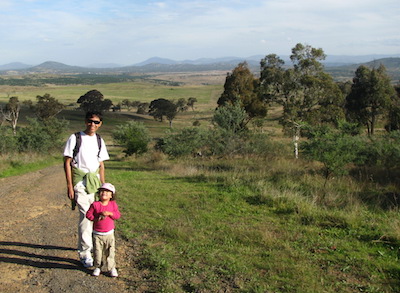
A Southwest view outside Canberra.
I grew up in Jakarta, which is on the island of Java. I studied and lived in Holland. Then I studied in Tokyo. All of those places were some of the most densely populated islands, countries and cities in the world. From all those “crowds” I ended up living in a very spacious city: Canberra. Canberra has been ranked as the best place in the world to live according to OECD in 2014. And from my personal opinion having lived in and visited many other cities in the world I believe that ranking is correct.
However there are a lot of things I miss about Indonesia. My family lives in Indonesia. I am fortunate that I can spend time with my family when I travel to Jakarta for work. One problem living in Canberra though is that there are few Indonesian restaurants so I really miss Indonesian food. I also miss the nice Indonesian tropical weather, the beautiful landscapes with beaches, lakes, volcanic mountains and rice terraces; things that you can enjoy all year round whilst only wearing T-shirt and shorts.
How do you maintain a balance between your work and the rest of your life? What is your favourite thing to do when you are not working?
My work is often not constrained by times that you must work between 8 AM to 5 PM because the people working on projects in Asia and Pacific countries. When the office is closed in Canberra our counterparts in Indonesia or Myanmar are still working. On many occasions communication needs to be done outside my office hours. I always see the balance is based both on the quantity and the quality of communication at professional and personal level. And the hours spent for both levels can be intertwined.
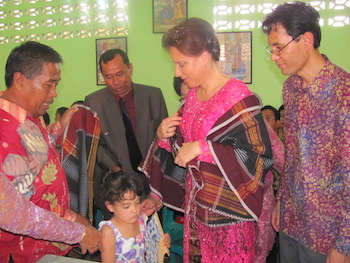
An ethnic Batak ceremony for my family held in North Sumatra, Indonesia.
Outside of work and professional organisation such as the AIBC I am also involved in the Indonesian Christian Community Fellowship in Canberra and the ethnic group of Batak people from North Sumatra who live in Canberra. With work and outside-work demands I am constantly challenged to find the right balance for those demands and time with my family.
As I said earlier Canberra is a top place to live. It is very green, spacious and clean from pollution where we enjoy many places to walk. We like to visit and explore towns or villages not far from Canberra and to find out how people live at the present time and in the past.
If you could give one piece of advice to anyone considering studying at GRIPS what would it be?
GRIPS provides students with high quality study. So make the most of it. Study hard and play hard. Spend time to enjoy Japanese cultural attractions, making friends with the locals, not only with your fellow international students and try to enjoy amazing Japanese food and explore some of the sights.
How would you like to maintain involvement with the School? What do you expect from GRIPS as an alumnus?
First I would like to express my gratitude for the continuous effort of Alumni Director, Karin Hillen and her team to connect alumni using Facebook. I use Facebook quite frequently to get the latest stories about GRIPS and its alumni and to get connected with alumni friends in many parts of the globe. I would also like to be engaged with GRIPS at a professional level. An example is the exploration of project or education collaboration between GRIPS and ANUedge and ANU. Collaboration through projects and/or education activities in the future using Australian or Japanese international aid funding can be explored too.
As an alumnus I hope that GRIPS will grow and continuously improve its education and research quality. GRIPS can assess the possibilities or pros and cons of commercialising public policy research contributing more to the society through international projects. This can strengthen GRIPS cooperation with international public institutions where GRIPS students come from and where international projects are implemented. This can also help expand the GRIPS network beyond its current public institution partners.
Do you have any suggestions on how to further utilize the GRIPS alumni network?
Conduct regular GRIPS professional alumni meetings such as public seminars in countries. Focus on issues unique to both GRIPS and the particular country (based on professors’ or researchers’ expertise) so that alumni and the country’s stakeholders such as government institutions or university partners will gain benefit from the events and it will enhance the networking for all parties. Assign this work to an alumni team to handle. Through such events, Japanese aid organisations such as Japan International Cooperation Agency (JICA) can use the alumni network to channel new program/project designs beneficial for the alumni’s institutions, GRIPS’s research and larger audience and communities.
With assessment or evaluation conduct a selection of 1 of the 12 alumni of the months in a year to find an Alumnus of the Year. Then invite this person to come to GRIPS to attend workshops to allow him/her to expand professional network. This is a good promotion tool for both sides: GRIPS and the person’s institution. Also give the opportunities for GRIPS students to learn from this Alumnus of the Year through presentation and discussions. This Alumnus of the Year will create an incentive for alumni to get in touch with GRIPS and to promote GRIPS internationally.




